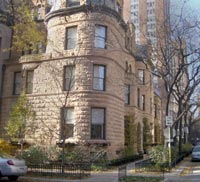Jamie Dimon, the banking executive who now heads New York–based JP Morgan Chase, has cut 11 percent off the asking price of the 26-room Gold Coast mansion where he lived while he ran Bank One. Originally listed at $13.5 million, the house now has a price tag of $12 million.
The broad house, faced with rough-hewn orange limestone, was built by Potter Palmer in 1889 as part of his effort to make the nascent Gold Coast into the fashionable new neighborhood. The architect Ernest Graham, of Graham, Anderson, Probst and White (think Wrigley Building and Field Museum), did a later expansion and remodeling. The house’s exterior is a many-textured composition of hefty stones, arched windows, copper-topped turrets, and dormers puncturing a steep roof.
It’s just as rich inside, with a dramatic cantilevered and curved staircase designed by Graham; ornate carved plaster moldings; and a door in the library, disguised as bookshelves, that leads to a downstairs retreat with a 2,500-bottle wine cellar and a walk-in safe. The second-floor master suite has five rooms, and there is an additional master-scaled bedroom suite on the third floor. The fourth floor has a domed entertainment room, a kitchen, and a 900-square-foot roof deck. As laid out now, the house includes a nanny room, a chauffeur’s apartment, and another two-bedroom apartment for the Dimons’ personal staff.
In August 2000, Dimon and his wife, Judith, bought the house from the attorney Thomas Demetriou, who had done extensive restorations to the then-faded gem. They paid $4.68 million and then launched their own series of renovations with the interior architect Marvin Herman. In 2004, Bank One became part of JP Morgan Chase, and Dimon became president of the larger company. He later became chairman and CEO. Fortune magazine reports that in 2006, Dimon’s total compensation was $41.2 million.
The Dimons listed the home for sale in April 2007, with an asking price of $13.5 million. Their agent, Mary Bennett of Koenig & Strey GMAC, says the amount the Dimons spent on renovations—particularly the technological upgrades—added to what they paid for the house exceeds that asking price. Bennett thinks things would have turned out differently had the house hit the market in summer 2006, when it first became clear the Dimons would be moving to New York. “It would have been history—gone at that price,” she says. “We don’t see houses come to the market with that much done to them. If you do that much to a house, you stay in it.” But she says her clients were “too busy to put it on the market” until this past spring, at which point the market had soured.
Just before Thanksgiving, the Dimons authorized Bennett to cut the asking price to $12 million. At that level, she says, the asking price is “far below the money they have in it.” The Dimons could not be reached for comment.





